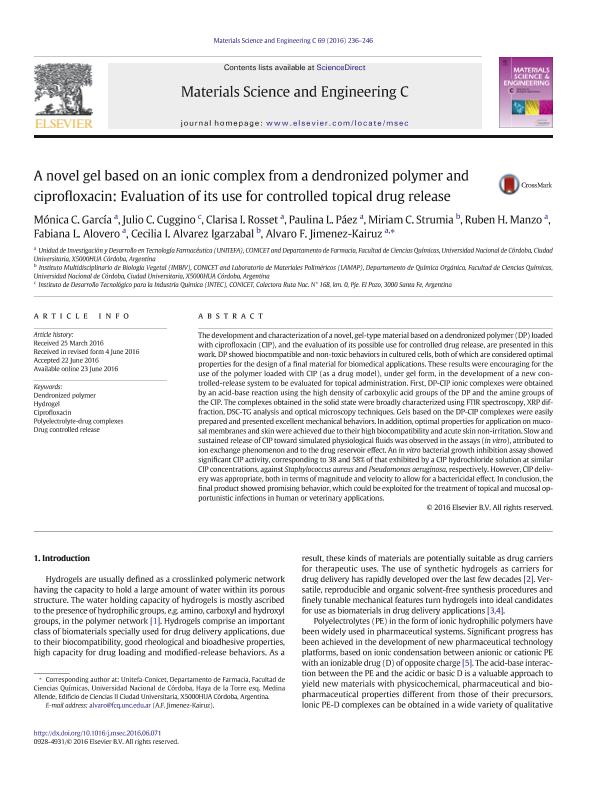Artículo
A novel gel based on an ionic complex from a dendronized polymer and ciprofloxacin: Evaluation of its use for controlled topical drug release
García, Mónica Cristina ; Cuggino, Julio César
; Cuggino, Julio César ; Rosset, Clarisa Inés
; Rosset, Clarisa Inés ; Paez, Paulina Laura
; Paez, Paulina Laura ; Strumia, Miriam Cristina
; Strumia, Miriam Cristina ; Manzo, Ruben Hilario
; Manzo, Ruben Hilario ; Alovero, Fabiana
; Alovero, Fabiana ; Alvarez Igarzabal, Cecilia Ines
; Alvarez Igarzabal, Cecilia Ines ; Jimenez Kairuz, Alvaro Federico
; Jimenez Kairuz, Alvaro Federico
 ; Cuggino, Julio César
; Cuggino, Julio César ; Rosset, Clarisa Inés
; Rosset, Clarisa Inés ; Paez, Paulina Laura
; Paez, Paulina Laura ; Strumia, Miriam Cristina
; Strumia, Miriam Cristina ; Manzo, Ruben Hilario
; Manzo, Ruben Hilario ; Alovero, Fabiana
; Alovero, Fabiana ; Alvarez Igarzabal, Cecilia Ines
; Alvarez Igarzabal, Cecilia Ines ; Jimenez Kairuz, Alvaro Federico
; Jimenez Kairuz, Alvaro Federico
Fecha de publicación:
01/12/2016
Editorial:
Elsevier Science
Revista:
Materials Science and Engineering: C
ISSN:
0928-4931
Idioma:
Inglés
Tipo de recurso:
Artículo publicado
Clasificación temática:
Resumen
The development and characterization of a novel, gel-type material based on a dendronized polymer (DP) loaded with ciprofloxacin (CIP), and the evaluation of its possible use for controlled drug release, are presented in this work. DP showed biocompatible and non-toxic behaviors in cultured cells, both ofwhich are considered optimal properties for the design of a final material for biomedical applications. These results were encouraging for the use of the polymer loaded with CIP (as a drug model), under gel form, in the development of a new controlled-release system to be evaluated for topical administration. First, DP-CIP ionic complexes were obtained by an acid-base reaction using the high density of carboxylic acid groups of the DP and the amine groups of the CIP. The complexes obtained in the solid state were broadly characterized using FTIR spectroscopy, XRP diffraction, DSC-TG analysis and optical microscopy techniques. Gels based on the DP-CIP complexes were easily prepared and presented excellent mechanical behaviors. In addition, optimal properties for application on mucosal membranes and skinwere achieved due to their high biocompatibility and acute skin non-irritation. Slow and sustained release of CIP toward simulated physiological fluids was observed in the assays (in vitro), attributed to ion exchange phenomenon and to the drug reservoir effect. An in vitro bacterial growth inhibition assay showed significant CIP activity, corresponding to 38 and 58% of that exhibited by a CIP hydrochloride solution at similar CIP concentrations, against Staphylococcus aureus and Pseudomonas aeruginosa, respectively. However, CIP delivery was appropriate, both in terms of magnitude and velocity to allow for a bactericidal effect. In conclusion, thefinal product showed promising behavior, which could be exploited for the treatment of topical and mucosal opportunistic infections in human or veterinary applications.
Archivos asociados
Licencia
Identificadores
Colecciones
Articulos(IMBIV)
Articulos de INST.MULTIDISCIPL.DE BIOLOGIA VEGETAL (P)
Articulos de INST.MULTIDISCIPL.DE BIOLOGIA VEGETAL (P)
Articulos(INTEC)
Articulos de INST.DE DES.TECNOL.PARA LA IND.QUIMICA (I)
Articulos de INST.DE DES.TECNOL.PARA LA IND.QUIMICA (I)
Citación
García, Mónica Cristina; Cuggino, Julio César; Rosset, Clarisa Inés; Paez, Paulina Laura; Strumia, Miriam Cristina; et al.; A novel gel based on an ionic complex from a dendronized polymer and ciprofloxacin: Evaluation of its use for controlled topical drug release; Elsevier Science; Materials Science and Engineering: C; 69; 1-12-2016; 236-246
Compartir
Altmétricas



